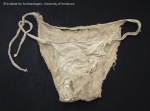Tuned in: Madonna, Vogue
In a recent conversation with friends, the topic of ancient underwear drew some attention. Most of us thought that the ancients up until the Victorian era (1837-1901) wore some kind of underwear, whether it was a loincloth, or ‘bloomers’ or ‘drawers,’ a camisole or corset. However, we did wonder if the European and later American populations in general wore what we consider underpants or something close to what we wear today. My curiosity piqued over this odd topic, I decided to investigate.
The first known underwear dates back to around 5000 BC. Whereas prehistoric man wore a breechcloth—strips of leather to protect his loins—later ‘after people learned to weave cloth, loincloths became the earliest form of underpants.’ A loincloth was wrapped around the waist, through the legs and tucked into the waistband. The loincloth was worn in many cultures of the ancient world from the Egyptians and Romans to the Incas, India and Chinese. Even in a modern world, Mahatma Gandhi was photographed wearing a white loincloth known as the ‘dhotis’ 
In the book, Underwear: A History by Elizabeth Ewing, the first evidence of underwear dates back to a statue in the Louvre of a Babylonian girl. She is wearing a brief that resembles a loincloth.
 In Egypt, women of status wore narrow tunics that extended from breast to ankle with shoulder straps, while men wore linen loincloths that resembled short skirts as underwear.
In Egypt, women of status wore narrow tunics that extended from breast to ankle with shoulder straps, while men wore linen loincloths that resembled short skirts as underwear.
Men in Rome and Greece are believed to have worn loincloths beneath their garments. It is not clear if Greek women wore a brief, but there is evidence that Roman women did.
In the Iliad and Odyssey and other classical works, women’s undergarments are mentioned. Greek women are described as wearing ‘a band of linen known as the zoné around the waist and lower abdomen to shape and control them’ (a modern day girdle). Also mentioned are two types of breast bands, one that covers the breasts and waist—apodesmos, and the other flattens the bust—mastodeton.
Roman men and women wore a subligar, an undergarment that came in two forms. One was a short pant or brief, the other was a loincloth. Women also wore a breast band called a mamillare. 
During the Middle Ages in Europe, ‘women wore coarse shifts over their loincloths for warmth’ (Swain 2008). The common man wore long shirts made from wool or rough linen, and loose fitting ‘braies.’ These linen, or wool drawers used for colder climates, varied in lengths but resemble modern day shorts. They were closed with a drawstring or cinched with a belt and the fabric tucked. Braies offered extra coverage. If a laborer, as depicted in the picture, became too hot he could ‘strip down’ to his braies and not offend anyone. 
In the 16th century the ‘codpiece’ a pouch that opened with buttons or snaps connected to the braies that allowed men to urinate without having to remove their breeches. By this time the braies became shorter to accommodate a form-fitting hose called ‘chausses’ and later with stylistic change this legging and codpiece functioned as outerwear. Henry VIII made them more fashionable when he began to pad his codpiece. [I can only imagine … but I think I’ll stop.] This fashion began to decline around 1590.
Unlike Swain’s view, cited above, some scholars are not sure if medieval women wore underpants. The long dresses medieval women wore often made it inconvenient to ‘remove underwear when answering nature’s call; on the other hand, some form of snug underpants could make life a little easier once a month,’ but there is no conclusive evidence ‘one way or the other.’ However, it’s possible that, at times, medieval women wore loincloths or short braies. The recent discovery in 2008 of a 600-year-old set of bras and an undergarment that looks like panties that experts claim are for a man, indicate that there may be aspects of Medieval clothing still unknown.
Women also wore a close-fitting garment called a chemise, shift, or smock under petticoats and later a corset. These were worn by the nobility to ‘protect expensive clothes from dirty bodies and to provide a layer of warmth.’ The corset (referred to as ‘pair of bodies’) was a stiff bodice made of buckram, whalebones, reeds and cane, and worn under a decorative bodice. 
The French Revolution revolted against underwear. Women abandoned their corsets, camisoles, and petticoats. These undergarments were viewed as ‘symbols’ of aristocracy. The return to a corset without stiffness and the Grecian breast band was a declaration of the democratic ideal that the French revolutionaries envisioned.
The 18th and 19th centuries brought new innovations. In the second half of the 18th century factories began to mass-produce underwear. ‘People began buying their undergarments in stores rather than making them at home.’ In the 18th century women began to use unboned or lightly boned stays now called corsets. In the 1820’s, as the tight waist became popular, the corset became boned and laced. By the 1860’s a ‘wasp’ waist was a symbol of beauty. Often the corset was fitted with whalebone or steel and tightly laced to achieve this end. By the 1880’s the reform against this style of dress took root because of the damage done to bones and eternal organs due to tight lacing.
lacing.
In 1856 the crinoline arrived replacing layers of starched petticoats (Swain 2008). ‘The crinoline was a petticoat stiffened with a cage of whalebone or steel hoops.’ These lighter skirts enabled wider skirts with some reaching six feet in width. According to Swain, women learned to maneuver stairs without seeing them, sitting without their hoops flying up, and being vigilant of the fire from an open hearth if their skirts passed too close. ‘And there was the problem of wind … underpants or drawers were needed now more than ever before.’
In the later 19th century, ‘bloomers’ appeared as part of bathing suits and bicycle outfits. The ‘union suit’ or in modern times, ‘long johns’ was a standard garment for men women and children.
So there you have it. The story of underwear from ancient times through the 19th century is broad and colorful. With the recent discovery of 600-year-old bras and undergarments in an Austrian castle, it seems that we may have only a partial picture at best of what people wore under their clothes to stay warm, clean to some extent and to protect themselves. Think of what we do today. Some women wear camisoles as an outer garment. We recently went through the —let a woman’s thong show above your jeans phase—and the ever so popular, ‘sagging,’ allowing men’s jeans to sag to their hips and display their boxer shorts. What will our future ancestors think of this? Perhaps, the same way I view the codpiece—?!?!? Any comments, reactions, or thoughts are especially welcome. Tell me what you think.
Ewing, Elizabeth. 1976 Underwear: A History; Swain, Ruth Freeman. 2008 Underwear: What We Wear Under There; Randomhistory.com/lingerie



So lucky to be living in the 21st century.
LikeLike
I think this is a very good article. It shows the difference between those that wore biblical clothing that does not hurt the skin and bones, vs. those that wear godly clothing which was called a loincloth. Hebrews used to wear loincloths for God.
LikeLike
Thank you. I found this an interesting topic to write about. As modern people, we often don’t think about how under garments have evolved over the centuries.
LikeLike
I’m old enough to remember the panty girdle, Cynthia – the 1960s version of the chastity belt – that I burnt along with my bra. 😉
LikeLike
LOL. I’m with you! The best bra I ever wore was a beautiful reversible corset that laced up the middle. I purchased it at a Renaissance Fair. It gave lift without the feel of shoulder and back straps. It’s really quite comfortable! I say to my friends, women were crazy to switch to the brassiere? The medieval corset is quite comfortable in my opinion!
LikeLike
Imagine Jesus giving His Sermon on the Mount to thousands of people — men and women and kids. There were no bathrooms, right? It would be better to wear nothing under the robes. But it must have stunk …
LikeLike
Definitely there were odors in the ancient world the modern era is spared; yet, I think there were certain rules and laws of cleanliness that many people followed. However, this topic would make for some interesting research!
LikeLike